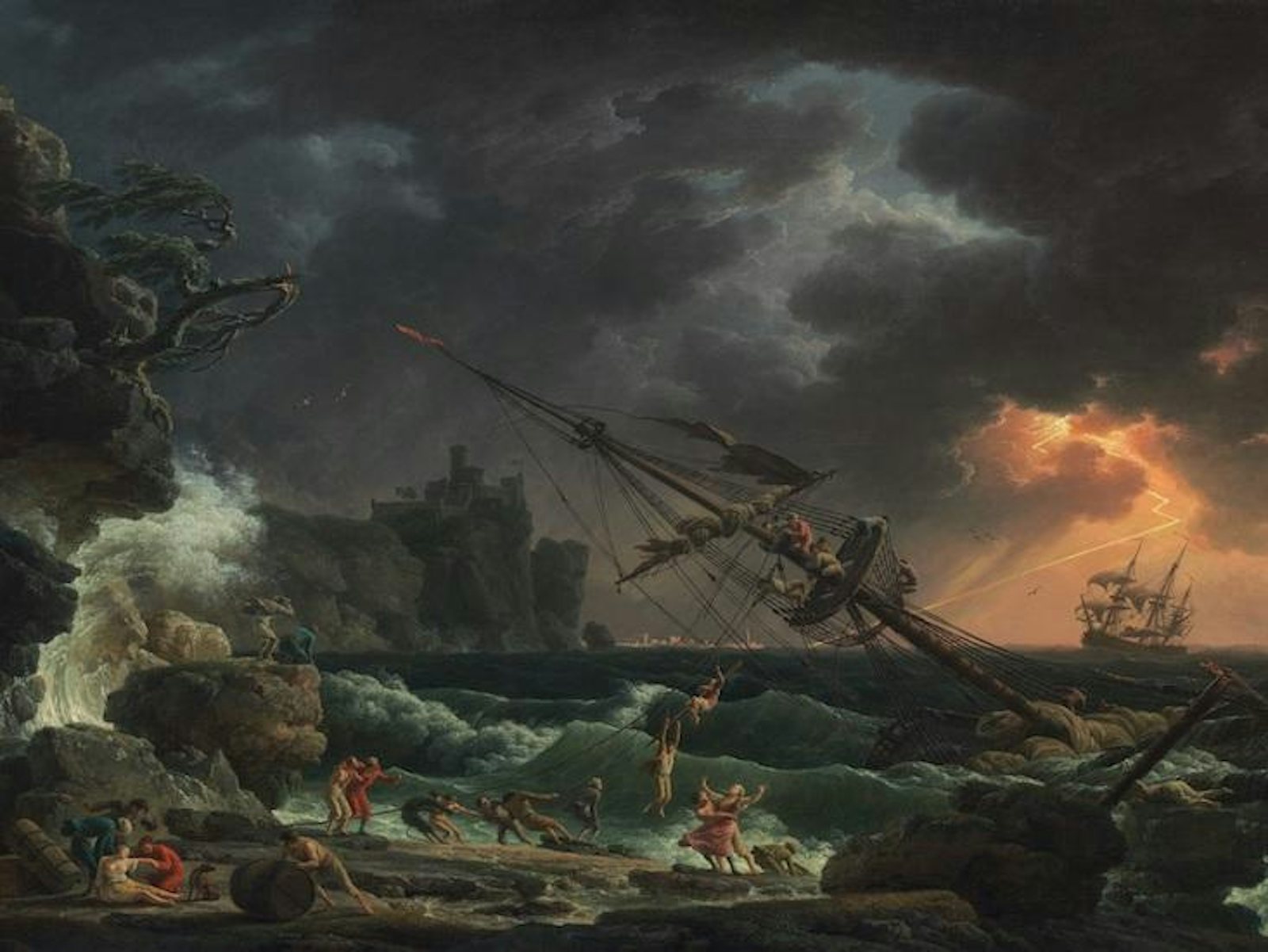To wish someone “good luck” is taboo aboard a ship. So are transporting bananas and whistling. But sighting a pod of dolphins can invite good fortune, I discovered last November, as I sailed 3,000 miles from Los Angeles to Honolulu. Wearing a gold hoop earring, I learned from one of my crewmates, who had one dangling from his left ear, is lucky, too. Many pirates believed tattoos and parrots also conferred the good fortune needed to survive the unwieldy conditions of a life at sea.
It’s no wonder sailing history is rife with superstition. Early sailors risked their lives every time they left the coast behind. On board a ship, the known world became, for long stretches of time, a distant memory. The crew was often cut off from the rest of humanity for periods of months to years. And shipwrecks were common. There was no weather forecast, no radio, no satellite communication. The dangers led the sea to become a subject for strange tales of monstrosity. Medieval and renaissance maritime maps are replete with colorful chimerical beasts curling out of the water, krakens and leviathans of the deep.
Yet, even today, when the risks are greatly diminished by modern technology and so many of the sea’s mysteries have been revealed, sailing superstitions persist. On my 23-day voyage aboard the S/Y Christianshavn, a 54-foot Danish sloop, the specter of luck was our constant companion and a feature of many mealtime conversations. Run by a Danish nonprofit called Plastic Change, the Christianshavn’s mission was to collect water and plastic samples from the Great Pacific Garbage Patch, and I had been invited aboard as the resident American journalist. Our crew was comprised of four scientists, a seasoned captain and first mate, and three other sailors. It was jarring to hear so much talk of luck in the midst of hard-nosed scientists.
Students made to feel a lack of control more often reported seeing images of animals, people, or foods where none existed.
It turns out that if what you do is really risky and dangerous, or involves lots of uncertainty, then you’re more likely to hold and practice superstitions. It’s not just sailing. Gambling, Wall Street trading, and baseball are just a few more examples. A hitter on a hot streak may refuse to wash his uniform or undergarments as long as he keeps getting on base, while some players name their bats to raise their game. And pitchers avoid stepping on the foul line when they come on or off the field. October is supposed to be an unlucky month for stock markets, a superstition that has stuck since the early 1900s. Many investors also believe in the Super Bowl Indicator: The stock market is expected to rise if a National Football Conference team wins the game. (From 1967 to 2003, this was correct 68 percent of the time.) When we feel we’re at the mercy of chance, we seek ways to feel in control. Enacting a superstition is a means of asserting that control.
“Superstitions create a form of structure in an unstructured world,” says Jennifer Whitson, of UCLA Anderson School of Management, a researcher who studies human behavior. Whitson calls the human inclination to seek and identify patterns between random or unrelated things or events, especially during times of uncertainty, “illusory pattern perception.” She’s found it’s this urge to connect disparate factors that appears to give rise to belief in superstitions. Whitson began studying this phenomenon in the mid-2000s. She initially ran six different experiments, all of which involved taking away varying amounts of control from her test subjects. After manipulating subjects’ sense of control, Whitson would assign them tasks that measured their propensity to engage in pattern-seeking behaviors.
For instance, in one experiment, part of a 2008 study, Whitson and her colleague Adam Galinsky asked 36 undergraduate college students to identify objects in 24 photos—otherwise known as the “snowy pictures task.” Half of the photos contained a grainy but distinguishable object while the other half were manipulated to be completely unidentifiable.

Before looking at the photos, Whitson had the students perform a basic computer-based test that required them to match widely recognized symbols with simple concepts (a sideways 8 with infinity, for example). The computer was programmed to give the students feedback about whether their answers were right or wrong. Half of the students, in order to induce a feeling of lack of control, received random feedback completely uncorrelated with the accuracy of their answers, while the other half were given accurate feedback. When they then looked at the “snowy” photos, students made to feel a lack of control more often reported seeing images of animals, people, or foods where none existed, compared with the students who received accurate feedback. “The need to be and feel in control is so strong,” Whitson and Galinsky write, “that individuals will produce a pattern from noise to return the world to a predictable state.”
There’s a Chinese superstition, shared by the Taiwanese, that the number “8” is lucky and “4” is unlucky.
Eric Hamerman, assistant professor at Iona College’s Hagan School of Business, has found that feeling in control via superstition tends to boost one’s optimism about the future—something which might be helpful to a sailing crew. In one 2013 study, he and his co-author Gita Johar asked their subjects to answer two sets of six trivia questions in two rounds, for a total of 24. Each round of questions was featured in a colored font against a different colored background (red font against blue, white font against orange).
The subjects received feedback on their answers after each set of six questions—but the feedback wasn’t entirely honest, just like in Whitson’s study: Subjects got positive feedback, whether they were right or not, with only one font-background color combination, which thereby made it the “lucky” one. When the subjects were told that there was going to be one more trivia session, and that they could choose which font and background color to use for the quiz, 64 percent chose the “lucky” one, the one linked to positive feedback in the previous rounds. Hamerman and Johar concluded, “Engaging in superstitious behavior creates a subsequent illusion of control over future outcomes.”
Despite the boost in optimism it can afford, being superstitious appears unhelpful, at least when it comes to investing. According to a 2014 paper titled “Do superstitious traders lose money?” irrationality is costly. There’s a Chinese superstition, shared by the Taiwanese, that the number “8” is lucky and “4” is unlucky. When the researchers examined limit orders (an offer to trade shares at a given price) in the Taiwanese stock market, they found that the most superstitious quintile of investors—which disproportionately submitted more orders at 8 than 4—notched returns on certain trades that were approximately 9 percent a year lower than those of the least superstitious quintile.
The question remains, why would scientists aboard a research ship with modern navigational technology engage in talk of luck? Shouldn’t they know better? “Superstitions may not be real,” says my Christianshavn crewmate Henrik Beha Pedersen, a scientist, sailor, and founder of Plastic Change. “But a little talk of magic is good fun; it can help the crew get through even the toughest days.” Perhaps that’s why some superstitions outlast the dangers they’re meant to ward off.
Erica Cirino is a freelance science writer based in New York. She covers wildlife and the environment, and specializes in biology, conservation and policy. Follow her on Twitter @erica_cirino.
WATCH: The UC Berkeley water chemist Richard Saykally explains why he invented a laser to study water.



























